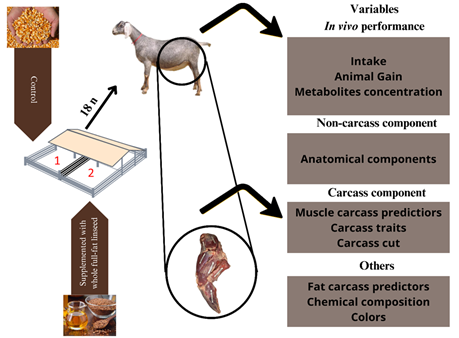1. Introduction
Goats represent a significant economic activity in various regions globally, particularly in Asia, Africa, and Latin America. These regions often grapple with low-quality pastures and water scarcity, conditions to which this species is highly adaptable, making them an excellent alternative for food production. Concurrently, a global interest in goat meat and dairy products has surged, primarily attributed to their nutritional and functional characteristics (Tiwari et al., 2022). These products are particularly popular in areas where bovine products are not readily available or commonly consumed.
Currently, the global goat population stands at approximately 1 billion, with around 203 million specifically bred for milk production, yielding an annual output of 15.2 million tons of milk (FAOSTAT, 2019). Given this scenario, the increasing number of does discard from dairy herds is becoming increasingly significant. Consequently, the need to establish a marketing channel for these carcasses and evaluate the meat derived from this category of animal is growing.
The issue of commercializing adult animals for the meat market continues to persist, particularly in tropical and subtropical regions where the largest herds are found. These regions, such as the northeast of Brazil, also utilize goats for meat production. The market in these areas is predominantly sustained by small producers and is marked by a lack of standardization. Animals are often slaughtered at a high weight and age (Souza et al., 2019).
High-quality carcasses are typified by a substantial proportion of muscle, a minimal proportion of bone, and an adequate amount and quality of intramuscular fat and cover. These traits align with those of adult culling goats, which possess little meat and approximately 50% to 60% of body fat stored in the abdominal cavity (Simela et al., 1999). These goats also exhibit extremely thin subcutaneous fat and a low content of intramuscular fat (Gawat et al., 2023), resulting in less succulence and tenderness in the final product. Consequently, the feeding programs implemented for these animals post-culling aim to expedite carcass finishing periods (4 - 8 weeks), contingent on the animal’s nutritional status.
The inclusion of lipids in dietary plans can be justified by their high energy value, making them beneficial for short-term diets. The incorporation of fats in ruminants’ diets offers several nutritional advantages (Joy et al., 2021), influencing fat deposition and carcass composition in relatively brief periods. However, limitations exist concerning the timing and level of lipid inclusion in the diet. According to Palmquist & Jerkin (2017), lipid inclusion should not surpass approximately 5% of dry matter. Excessive lipid levels can inhibit the absorption of free fatty acids to food particles, preventing direct contact of microbial cells with the substrate (Ponnampalam et al., 2024). This results in reduced nutrient digestion and a decrease in microbial growth (Beauchemin et al., 2008). At the ruminal level, diets with higher lipid content reduce the fermentation of fibrous carbohydrates, leading to an increase in the intestinal flow of microbial protein and a decrease in ruminal ammonia concentration (Panahiha et al.; 2023; Simionatto et al.; 2024).
Contrarily, recent literature has reported the effective use of high fat levels (>5%) in short-term goat diets without adverse effects (Bezerra et al., 2023). This dietary adjustment has been linked to improved animal productivity (Nogueira et al., 2019). These findings present new opportunities for incorporating fat into adult goat diets to influence carcass traits and, subsequently, meat quality.
The premise of this study is that incorporating high fat levels into the finishing diets of cull goats does not affect the animals’ acceptance of the diet or their performance, and it effectively enhances carcass traits and meat quality. Consequently, this research aims to investigate the impact of a high- lipid diet during the finishing phase on adult cull goats’ food consumption, metabolic profile, in vivo performance, anatomical and carcass characteristics, and meat quality.
2. Methodology
Location, animal, and experimental treatments
This research was carried out from July to August at a farm affiliated with the School of Veterinary Medicine, Ceará State University, situated in Brazil’s equatorial zone (4°2ʹ23ʺ S and 38°38ʹ14ʺ W). The region is distinguished by a consistent photoperiod regimen and features a warm, tropical, subhumid climate. The mean annual rainfall and temperature are 904.5 mm and 26 - 28 °C, respectively. The area experiences two distinct seasons: a rainy season from February to May and a dry season from June to January.
Eighteen pluriparous, non-pregnant, adult, crossbred Anglo-Nubian goats of similar body weight, age, body condition, height at withers, body length, and subcutaneous sternal fat thickness (Table 2) were utilized in this study. These animals, surplus from the University Experimental Farm flock, were housed in individual shelter-clayed open boxes and had free access to mineral supplements and water. For 28 days leading up to slaughter, the goats underwent a fattening program designed for culled adult animals. This program was based on a finishing diet composed of chopped elephant hay and concentrate, provided in quantities sufficient to meet three times the nutritional requirements of adult non-dairy maintenance goats (NRC, 2007). The female goats were divided into two groups: one group was fed the baseline diet without fat supplementation (WFS group; n = 9) and the other group received a diet supplemented with whole full-fat linseed (FSWFL group; n = 9; Figure 1).
The diet was dispensed twice a day. Any uneaten feed was gathered and weighed daily to ascertain individual consumption and dietary adjustments. Prior to the experiments, the goats were subjected to a 15-day management adaptation period following endo-and ectoparasitic treatments and were immunized against clostridiosis.
The body condition score (BCS) was evaluated using the method outlined by Morand-Fehr (1981). Scores were assigned on a scale of 1 to 5, with 1 representing very thin and 5 indicating obesity. These scores were further divided into quartile intervals of 0.25.
Diets and chemical composition
Table 1 presents the food ingredients and the average chemical composition of the diets.
Table 1 Ingredients and chemical composition of diet without fat supplementation (WFS) and with fat supplementation of whole full-fat linseed (FSWFL)
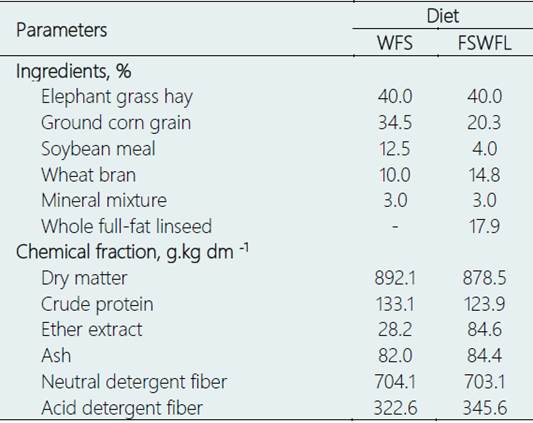
The diets varied in fat content, with one containing 2.8% and the other 8.4% DM. The proximate composition of the diet samples was determined in accordance with established methods (AOAC, 1990). Feed and feed orts samples were dried in a forced-air-circulation oven at 55 °C for 72 hours, then ground in a Wiley mill to pass through a 1 mm screen. The samples were subsequently analyzed for DM (method 934.01), ash (method 942.05), EE (method 920.39), and crude protein (method 978.04). The neutral detergent fiber was determined using α-amylase, without the addition of sodium sulfite (method 973.18), as recommended by the relevant authority (Van Soest et al., 1991). The acid detergent fiber content was ascertained using the method described by the appropriate source (Robertson & Eastwood, 1981).
In vivo performance and ultrasonography carcass markers
The animals underwent weekly weight assessments, and their fat and muscle mass were gauged using B-mode ultrasound instrument equipped with a 5 MHz linear probe (Shenzhen Mindray Bio-Medical Electronics Co., LTD, model DP-2200Vet, Shenzhen, China). Measurements of loin muscle depth, loin area, and subcutaneous loin fat thickness were taken between the third and fourth lumbar vertebrae, adhering to the methodology outlined by Teixeira et al. (2008). The thickness of subcutaneous and internal sternal fat deposits was determined at the third sternebrae, as per Hervieu et al. (1991). Each image was captured in triplicate and measured using the pre-calibrated ImageJ program (ImageJ, National Institutes of Health, Millersville, USA). During the evaluation, the animal remained stationary. The right side of the body was shaved, and gel was applied as a coupling agent to enhance image quality.
Cholesterol and triglycerides assays
Blood samples were collected weekly in the morning prior to food administration, utilizing heparinized vacutainer tubes (Firstlab®, Disera Tıbbi Malzeme Lojistik San. Tic. A.Ş, Izimir, Turkey). Following collection, the samples were subjected to centrifugation at 3000 rpm for a duration of 10 minutes to facilitate plasma separation. The separated plasma was subsequently stored at a temperature of -20 °C.
Plasma concentrations of cholesterol and triglycerides were measured using a Mindray BS 120 automated biochemical analyzer (Mindray Biomedical Electronics Co., Shenzhen, China) and commercial kits (Bioclin, Quibasa, Minas Gerais, Brazil). The assay sensitivities for cholesterol and triglycerides were 1.472 mg/dL and 2.845 mg/dL, respectively, as specified by the manufacturer for biological fluid analysis.
Anatomical records
After the 30-day finishing diet, the animals were weighed, then subjected to a 16-hour fast, both solid and liquid. Following the fast, the animals were weighed again to determine their fasting live (FW) weight. They were then euthanized in accordance with RIISPOA standards (BRASIL, 2017). Subsequent procedures included skinning, evisceration, and the removal of the head and extremities. After evisceration, the anatomical components, including the skin, head, mammary gland, feet, blood, lungs, trachea, esophagus, diaphragm, heart, kidneys, liver, and spleen, were weighed.
Fat deposits from the omentum, heart, kidney, and mesenteric were also weighed. The components of the gastrointestinal tract, specifically the stomachs and intestines, were weighed both full and empty. After being emptied and washed, they were weighed again to determine their content and the empty body weight (EBW) of the animals.
Carcass components
Following evisceration, the carcass was weighed to ascertain the hot carcass weight. The carcasses were subsequently stored at 4 °C for a duration of 24 hours. After this period, they were reweighed to determine the cold carcass weight and determinate the weight loss due to cooling. The carcasses were then longitudinally bisected. Commercial cuts, including the shoulder, ham, loin, ribs, neck, and flank, were executed on the left half-carcass, as delineated by Araújo et al., (2017).
Physiochemical attributes of loin
The loin from each slaughtered goat was identified, wrapped in parafilm, and stored at -20 °C in a freezer for subsequent tissue composition analyses. For these analyses, the loin was thawed within plastic bags in a refrigerator set at 10 °C. The pH and CIE L*, a*, b* color attributes were measured on the loin chop’s surface at 45 minutes and 3, 6, 12 and 24 hours post-mortem. Color determination involved three consecutive measurements using a CM-2500d® spectrophotometer from Konica Minolta, Japan. A digital pH meter (Testo SE & Co. KGaA®, model 205, Lenzkirch, Germany) was employed to ascertain the muscle pH.
The proximate composition of the loin was ascertained in accordance with AOAC (2002). Moisture content was determined by oven-drying a sample at 105 °C until a constant weight was achieved. The Kjeldahl method was employed to ascertain the nitrogen content, which was then converted to crude protein using a conversion factor of 6.25. The fixed mineral residue was determined through incineration at 550 °C. Total lipids were quantified using a hot extraction process with an organic solvent (hexane) at 120 °C.
Statistical analysis
Statistical analyses were conducted using Statistica Software version 13.4.0.14 (2018; TIBCO Software, Inc., Palo Alto, CA, USA). The data were first checked for mathematical assumptions using the Kolmogorov-Smirnov and Bartlett’s tests. If these conditions were not satisfied, a log10x transformation was implemented. All descriptive data were examined using a completely randomized design and subjected to ANOVA GLM procedures. The effect of diet was tested for initial goat traits, anatomical records, carcass traits, and fat deposit weights (WFS, FSWFL). For dry matter intakes, weight gains, and metabolite levels, the factors considered were diet, sampling interval (time), and the interaction between diet and time. The GLM procedures for repeated measures of ANOVA were used for ultrasonography measurements of carcass predictors, with the effects tested being diet, the interval of assessment (time), and the interaction (group vs. time). The recorded anatomical images (1, 2, and 3) were treated as repeated measures. All pairwise comparisons were conducted using the Newman-Keuls post-hoc test.
The characterization of the observations from each trial was verified using principal component analysis (PC) through the generation of indices summarizing the intake/gain and carcass component or non-car cass component variables and represented in biplot graphs. The eigen values and eigenvectors were calculated from the correlation matrix to ensure that the results were not biased by large numerical variables. The choice of the number of components was based on the PC that obtained eigenvalues greater than1, according to the Kaiser criterion.
Ethical statement
The Ethics Committee on Animal Experimentation of the UECE approved all procedures implemented in this study (No. 3047564/2017, CEUA-UECE).
3. Results and discussion
The high-fat diet group exhibited a significantly higher dry matter intake (p < 0.001) than the control group (Table 2). Despite the high-fat group consistently consuming more food throughout the entire finishing period, a 13% reduction was observed in the first week compared to that in subsequent periods. This trend was not mirrored in the control group, indicating a significant interaction between diet and time (p < 0.001).
While both daily and total weight gain were comparable across diets (Table 2), a significant interaction was observed between diet and feeding time in the daily weight gain parameter (p = 0.022). This outcome can be attributed to the varied performance recorded. In the control group, a progressive reduction in daily weight gain was noted from the second week of feeding, culminating in the lowest value during the final week of fattening (-70%). During this period, the daily gain varied between weeks (155.7 ± 37.9 g\day vs. 45.7 ± 17.8 g\day: P < 0.05). Conversely, the fat group exhibited a rise (+59%) in daily weight gain from the second to the fourth week of fattening (57.1 ± 21.2 g\day vs. 140.0 ± 33.3 g\day: p < 0.05).
The diet supplemented with fat resulted in a significant increase in peripheral cholesterol (P = 0.015) and triglycerides (P = 0.011) among the plasma lipid metabolites (Table 2). The results can be observed through principal component analysis (PCA; figures 2 and 3), which shows that animals fed whole flax seed had greater tendencies to increase cholesterol and triglyceride levels.
Despite dietary fat values exceeding the recommended levels for ruminants, the animals’ response was not negatively impacted. Instead, there was a notable increase in food consumption during the experimental period. Literature suggests that a decrease in DM intake might be expected when dietary fat concentration surpasses the 5-6% recommended for ruminants (Palmquist & Jenkins, 2017). However, Bezerra et al. (2023) observed an increase in dry matter intake when feeding goats with 6.3% dry matter. Similarly, Nogueira et al. (2019) added an 8% fat concentration to cow feed and found no difference in dry matter intake between treatments.
Lipid supplementation should be approached with caution. The results indicate that α-linolenic acid (C18:3 n-3), the most abundant fatty acid in flax seed, induces more prominent toxicity in ruminal bacteria than do other C18 fatty acids (Lima et al., 2024). As anticipated, the increased consumption of dietary lipids led to plasma hyperlipidemia in the high-fat group, as evidenced by the rise in peripheral triglycerides and cholesterol. This alteration in lipid metabolites positively influenced weight gain dynamics, which improved over the finishing weeks, unlike the results seen with the base diet. This outcome can be attributed to enhanced palatability and feed efficiency, as well as an increase in the energy density of the diet (Joy et al., 2021). Our findings align closely with those reported in the literature. Both diets resulted in an average gain of 97.1g/day.
Dhanda et al. (1999) noted that with increasing age, the average daily gain decreases regardless of breed. In their study, animals raised for chevon carcasses, with a live weight range of 30 to 35 kg, had an average gain of just over 100 g/day across different genotypes. Brand et al. (2017) found that in the Boer breed, which is specialized for meat production, high levels of metabolizable energy in the confinement of young animals resulted in a daily gain of up to 291g/day over 40 days of finishing.
Diet had no impact on fasting live weight, net weight excluding gastro-enteric content (Table 3), or the weights of anatomical components documented at slaughter. The diet had no impact on either the loin eye area or the loin depth, both of which were measured using ultrasonography throughout the experi mental period (Table 4). The groups exhibited com parable carcass weight, cooling loss, and carcass yield. Additionally, the weights of the primary com mercial cuts remained unaffected by the diet.
Table 2 Means and standard errors of body weights and animal attributes at initial of trial, dry matter intakes recorded during the experiment, daily weight gain, total weight gain, and plasma fat metabolites concentrations in culled adult goats finished for 28 days with high-fat diet
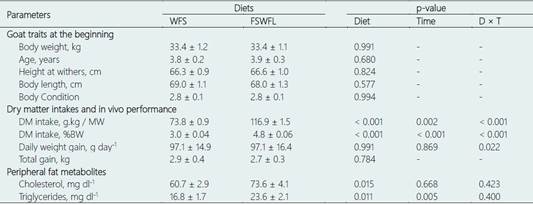
WFS = without fat supplementation, FSWFL = fat supplementation of whole full-fat linseed, D = diet, T= time. SSFT = subcutaneous sternum fat thickness; DM = dry matter, MW metabolic weight, BW = body weight.
Table 3 Means and standard errors of anatomical components in culled adult goats finished for 28 days with high-fat diet
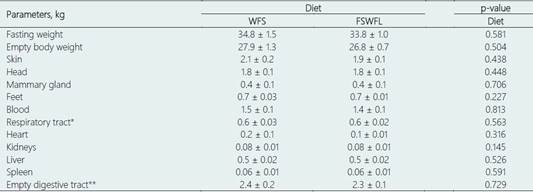
WFS = without fat supplementation, FSWFL = fat supplementation of whole full-fat linseed, D = diet, T= time. * Lungs + trachea + esophagus + diaphragm. ** Stomachs + intestines.
Table 4 Means and standard errors of carcass predictors and carcass traits in culled adult goats finished for 28 days with high-fat diet
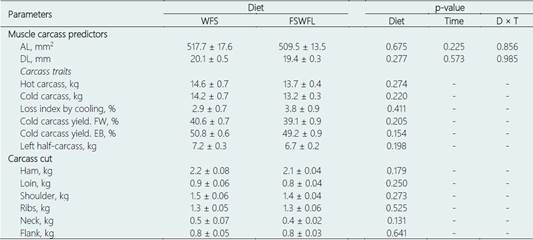
WFS = without fat supplementation, FSWFL = fat supplementation of whole full-fat linseed, D = diet, T= time. AL = loin area, DL = loin depth, FW = fasting weight, EB = empty body weight.
The traditional finishing system for cull animals typically involves a high-energy diet for a limited duration. This feeding strategy, as demonstrated in the current study, is designed to maximize the impact of a temporary energy surplus, primarily stimulating adipogenesis to enhance the commercial value of these animals at slaughter. Indeed, adult does, particularly dairy ones, are morphologically lean, exhibiting low deposition of subcutaneous and intramuscular fat. Consequently, they possess low commercial value for the meat market at the time of disposal (Pophiwa et al., 2020). In adult goats, there is a prevailing trend towards increased deposition of visceral fat at the expense of other anatomical sites (Webb, 2014; Lerch et a., 2021).
Although in vivo performance demonstrated a distinct interaction with supplementation duration, the data collected at slaughter failed to distinguish any benefits between the diets. Consequently, the anatomical components, the carcass and cuts’ quantitative attributes, and the distribution of carcass fat deposits remained unaffected by the fat addition, which can be observed by the principal component analysis performed (figure 2 and 3).
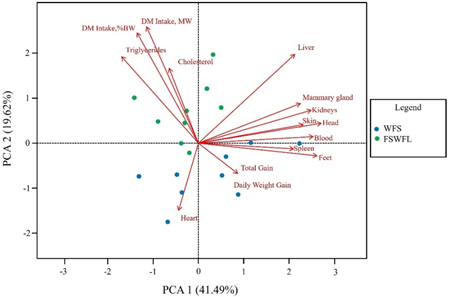
Figure 2 Biplot representation of the first two principal components obtained from intake/gain variables and non-carcass component variables.
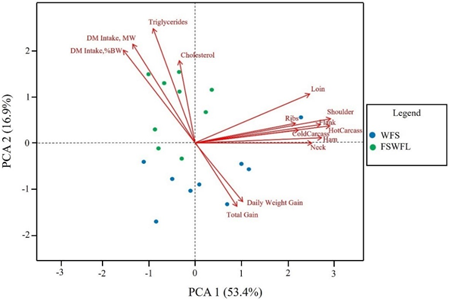
Figure 3 Biplot representation of the first two principal components obtained from intake/gain variables and carcass component variables.
In terms of post-mortem parameters and non-carcass and carcass components, Vizzielli et al. (2021) found similar results, albeit in a study involving kids subjected to 40 days of flaxseed supplementation. In our study, this observation is partially justified, given that we are dealing with adult animals.
The thickness of both sternal and lumbar subcutaneous adipose deposits exhibited no significant difference between the diets (Table 5). Additionally, the sternal deposit demonstrated a consistent increase (0.7 ± 0.2 mm) throughout the experiment in both groups (time effect; p = 0.009). As for the internal sternal adipose thickness, it was notably higher (p = 0.042) in the group that received fat supplementation.
Upon slaughter, the weights of adipose deposits in the kidney, omental, and mesenteric sites were documented for the high-fat group, whereas the cardiac deposit was heavier in the control group. Despite these measurements, the diet did not significantly affect any of the aforementioned parameters, and the two groups were statistically indistinguishable (p > 0.05).
In both groups, omental fat deposits constituted less than half of all body fat deposits, at 48.3%. This was followed by perirenal fat deposits at 25.1% and mesenteric and cardiac fat deposits at 23.4% and 3.1%, respectively. No significant difference was observed between the groups in terms of the incidence of adipose mass in net body weight, which averaged at 7.2% (Table 5).
Except for subcostal sternal fat thickness, ultrasound monitoring revealed no alterations in the measurements of the loin muscle area or sternal subcutaneous fat thickness. Among the carcass predictors, only the thickness of lumbar subcutaneous fat showed increased sensitivity to the duration of diet administration. Kang et al. (2019;2020) assert that total cholesterol concentrations rise when cattle are supplemented with protected fat. This plasma effect contributes to increased adiposity, primarily visceral fat and subcutaneous fat (Bionda et al., 2022). This leads to weight gain in animals, a consequence of an imbalance between energy absorption and expenditure, resulting in fat accumulation in white adipose tissue (Seo et al., 2017).
Overall, the findings imply that the selected lipid inclusion level and the duration of diet exposure failed to stimulate a sufficient metabolic response to achieve a difference in adipose deposition. The thickness of the subcostal or internal sternal fat, known to be a strong indicator of nutritional status (Hervieu et al., 1991), showed no variations over the diet administration period. Furthermore, the lack of interaction between diet and time suggests that the observed differences between the experimental groups in the study are attributable to the inherent traits of the sample animals.
Table 5 Means and standard errors of fat carcass predictors and body fat depots in culled adult goats finished for 28 days with high-fat diet
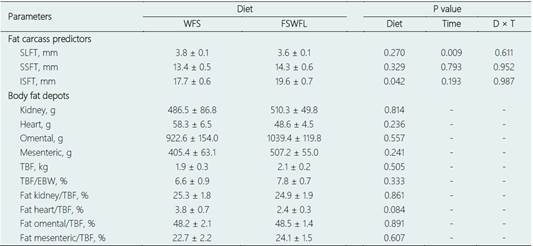
WFS = without fat supplementation, FSWFL = fat supplementation of whole full-fat linseed, D = diet, T= time. SLFT = subcutaneous loin fat thickness, SSFT = subcutaneous sternum fat thickness, ISFT = internal sternum fat thickness. TBF = total body fat, EBW = empty body weight.
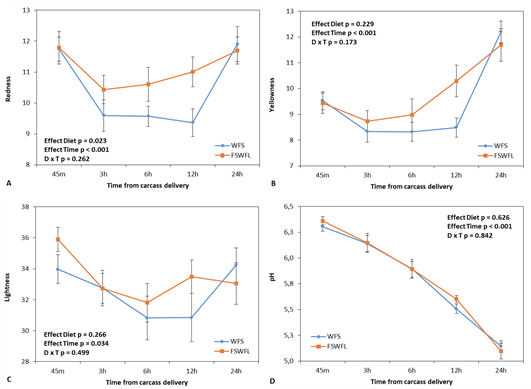
Figure 4 Means and standard errors of color components, redness (Figure 4A), yellowness (Figure 4B), lightness (Figure 4C), and pH (Figure 4D) changes over time of loin in culled adult goats finished for 28 days with high-fat diet. WFS = without fat supplementation, FSWFL = fat supplementation of whole full-fat linseed. ANOVA results for effects of diet, time, and interaction of diet vs. time are given.
Contrary to adipose deposition, the lack of weight gain in muscle mass was anticipated, given the animals’ age (Brand et al., 2017). For meat production, the carcass’s quantitative characteristics are crucial as they constitute the fraction with the highest commercial value. Notably, most studies on goat slaughter focus solely on the carcass as a marketable unit, overlooking other edible parts of the animal's body (non-carcass components). These components represent an additional income source and could contribute to feeding populations. The sale of these components provides economic benefits to producers by adding value to the product. Similar to carcass components, non-carcass components can be modified by the nutrition used in animal finishing (Gama et al., 2020).
Conversely, the qualitative attributes of the carcass, including subcutaneous and intramuscular fat deposition, play a crucial role in attracting buyers and facilitating market expansion. Therefore, mature animals like adult goats can be subjected to nutritional plans designed to enhance performance and carcass quality. The strategy of finishing animals in confinement is often employed to improve the carcass finish of animals destined for slaughter. When these animals are mature, or of a more advanced age, the diets used should be higher in energy to promote fat deposition in the carcass. However, the age at slaughter can influence quality indicators such as meat tenderness (Borgogno et al., 2015). While the primary method of goat meat commercialization is through whole or half-carcasses, there is potential for commercialization, processing, and product generation from these (Oliveira et al., 2021).
No differences were noted between the diets concerning the parameters of proximate composition, as demonstrated in Table 6, based on the analysis conducted on the loin. The pH values of the loin (Figure 4D) demonstrated a significant decrease over the evaluation period in both groups (effect time p < 0.001), with no discernible differences between the diets. In terms of the color components of the loin, the high-fat group exhibited higher red ness values (Figure 4A), (11.1 ± 0.2 vs. 10.4 ± 0.2; p = 0.026). However, the yellow color component (Figure 4B) and luminosity (Figure 4C) remained consistent across both diets. The color components exhibited a decline in values from 45 minutes to 3 hours postmortem (for redness and yellowness) or from 45 minutes to 6 hours postmortem (for lightness), before increasing again at 24 hours postmortem (effect time; p < 0.05).
Table 6 Means and standard errors of loin proximate composition in culled adult goats finished for 28 days with high-fat diet

WFS = without fat supplementation, FSWFL = fat supplementation of whole full-fat linseed.
The current study examined the qualitative properties of meat, revealing that a four-week lipid supplement did not significantly alter the composition of the loin or the dynamics of its physical parameters during post-mortem evaluation. However, an unexpected increase in the intensity of the meat’s red coloration was observed. This outcome, while surprising, is plausible in adult animals where additional metabolic lipid intake may intensify the action of myoglobin in muscle fibers. These animals typically exhibit darker, more intensely colored meat. It is well-established that the color of fresh meat is primarily determined by the relative amounts of three forms of myoglobin (Stafford et al., 2022), myoglobin in its reduced state or purple-red deoxymyoglobin, bright red oxygenated myoglobin or oxymyoglobin, and brown oxidized myoglobin or metmyoglobin. Faustman & Cassens (1990) identified a strong correlation between lipid oxidation and myoglobin oxidation, with radicals produced by lipid oxidation potentially promoting metmyoglobin accumulation. However, the causal relationship between myoglobin oxidation and lipid oxidation remains unclear (Ladeira et al., 2014). This characteristic could potentially impact consumer acceptability, as darker goat meat is often associated with a low degree of tenderization (Pophiwa et al., 2020).
The findings of this study substantiated the original hypothesis. The inclusion of fat in the diet demonstrated efficacy in the in vivo response of adult culled goats but did not show significant benefits concerning carcass or meat quality. In goat production systems, the culling of breeding females is a standard herd management practice and a significant source of additional income on rural properties. Typically, these females are slaughtered for meat sale following a kidding season. Adult animals, over two years old, tend to dominate goat markets in developed countries and formal markets in developing nations (Webb, 2014).
4. Conclusions
Our study’s experimental conditions demonstrated that diets with high lipid content stimulate food intake and in vivo performance in cull goats, without inducing detrimental alterations in peripheral lipid metabolites. However, despite these findings, we found no evidence to suggest that the diet improves carcass characteristics or meat quality. Therefore, the use of fat finishing in culled goats to enhance meat market value remains unjustified.














